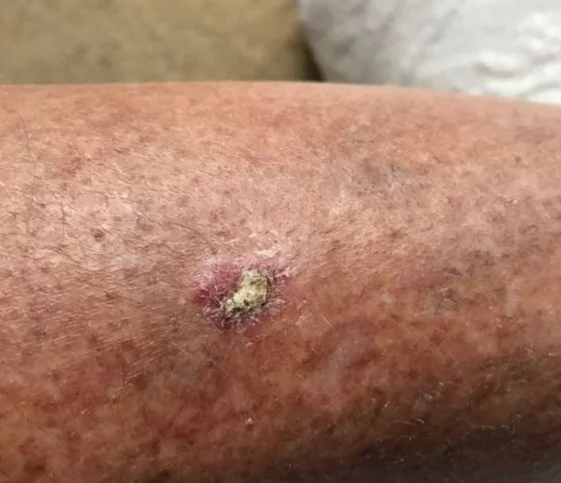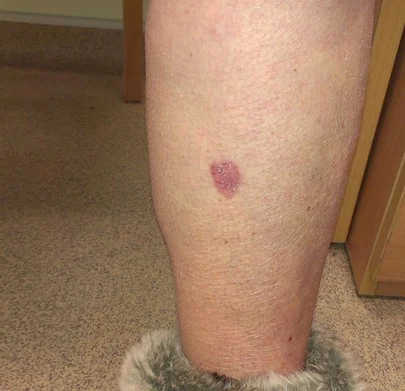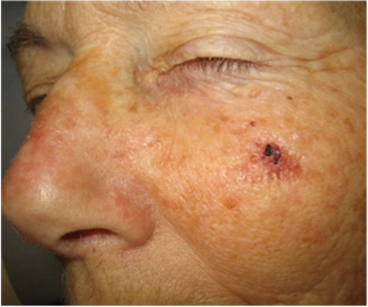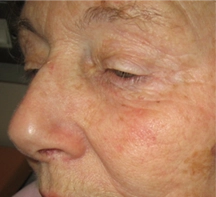What is Bowen’s disease or Squamous Cell Carcinoma in situ?
Bowen’s disease or Squamous cell carcinoma in situ, is a growth of sun-damaged cells that is confined to the surface layers of the skin. They present as itchy scaly areas of skin. They may be single or multiple. There is a small risk of a type of skin cancer called Squamous Cell Carcinoma which may develop in areas of Bowen’s disease, but this risk is very small and affects less than 3-5% of patients.
What are the symptoms of Bowen’s disease?
Bowen’s disease generally causes no symptoms apart from occasional itching and scaling of the skin. It is not unusual for the patches of Bowen’s (particularly on the legs) to remain unchanged for many years. Many older patients prefer not to have treatment because they cause few problems.


What do the lesions look like?
A patch of Bowen’s disease starts as a small red scaly area, which grows very slowly. Most are 5-8mm in diameter, but they may grow in some individuals to be 2-3 cm over time (or occasionally larger).
They are most frequently seen on sun-exposed skin, especially the face, scalp and neck, as well as the hands and lower legs. More than one area may be present.
What are the warning signs of suspicious change?
Bowen’s disease generally causes few symptoms and the presence of pain, growth of a lump or skin breakdown (ulceration) may be a sign of early skin cancer.
Such changes would normally require a review by your GP, who may choose to refer you for further clinical assessment. A skin specialist may need to treat the area or arrange a biopsy.
How is it diagnosed?
The diagnosis is usually made by the clinical appearance. Occasionally a biopsy (a small sample of skin) may be needed to make the diagnosis. The most common way of performing a biopsy is a technique called curettage, which involves a scrape of the skin under local anaesthetic. A sample is then sent away to the histopathologist for analysis, which may take up to four weeks.
Treatments for Bowen's disease
A number of treatments are available for bowen’s disease:
Conservative management
In many older patients with multiple lesions on the lower legs or in those patients with extensive sun damage no further treatment is required. Any symptoms such as itch or scaling may improved with the use of moisturising creams.
Cryotherapy
Cryotherapy is usually only available in specialist clinics. It involves spraying cold liquid nitrogen on the surface of the skin for 10-12 seconds. This is a painful treatment causing skin redness, puffiness, blistering or crusting, and may be slow to heal. On the lower legs, the skin may take several weeks to heal. Complications include a post-cryotherapy white scar and they may re-occur.
Efudix® cream
Efudix® is a very effective treatment that can be prescribed by your primary care doctor. It works by destroying abnormal skin cells allowing healthy skin to heal from underneath. When applying the treatment, we recommend that you treat small areas first whilst getting used to the cream.
Efudix® is applied twice daily for 3-4 weeks or once daily for 4-6 weeks to a small area of affected skin. It must be applied to a very small area and no larger than the size of the palm of your hand for the first course (less than 8-10cm2). This is because it can cause intense inflammation in both the lesion and any surrounding skin that has early sun-damage. With time, some patients find they can treat larger areas, but most find it is better to apply to a small area and then move to other areas over a number of weeks. If you apply it to the whole face or scalp, it can cause significant inflammation and whilst this is not serious, it can look very unsightly.
Treatment may need to be stopped for a few days if the reaction is very intense. You may need to ask your GP to prescribe a topical steroid/antibiotic (Fucibet® cream) if the reaction is severe and unexpected. It is 85% effective and is very effective for multiple unstable lesions. Treatment courses can be repeated or rotated around different areas. Some experienced users find it can be used for 2-3 weeks on individual lesions that crop up with good results.
Curettage under local anaesthetic
This involves scraping off the abnormal skin under a local anaesthetic with a device called a curette. The area then heals with a scab, like a graze. The healing of the skin may take on average 12-14 days, but this could be longer on the lower legs.
Surgical excision under local anaesthetic
The abnormal skin can be cut out, under local anaesthetic, provided it is not too large. This involves cutting around the lesion and stitching the skin which will leave a scar. If this method of treatment is chosen, you will be informed about the type of surgery planned and any other potential complications.
Photodynamic therapy
A chemical is applied to the skin that makes the cells in the patch of Bowen’s disease sensitive to particular wavelengths of light. Light from a specially designed lamp is then shone onto the patch.
This treatment can be painful and cause inflammation; however, any inflammation should disappear within a few days (see Patient Information Leaflet on Photodynamic Therapy).


Self-care
It is important to use high-factor sun-screens (SPF>50) on a regular basis and generally protect your skin from the sun.
How are different treatments selected for patients?
Treatments depend on the location, size, and thickness of assessed skin lesions. Higher risk lesions include larger lesions and those that are changing. Treatment options can always be discussed with a member of the specialist team. Conservative management is often the best option in older patients unless skin cancer is suspected.




